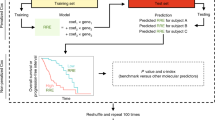Abstract
Deep molecular characterization of tumors is a prerequisite for precision oncology and personalized anticancer treatment. Analyzing the tumor transcriptome by RNA sequencing (RNAseq) allows the quantification of individual isoforms and also the detection of sequence alteration in the expressed genes. This chapter describes an analysis pipeline that focuses both on accurate quantification of transcripts and on the occurrence of cancer-associated mutations. Another section introduces the analysis of differentially expressed genes for biomarker evaluation on the example of comparing metastasized versus non-metastasized colorectal tumors.
Access this chapter
Tax calculation will be finalised at checkout
Purchases are for personal use only
Similar content being viewed by others
References
Ramaswamy S, Ross KN, Lander ES et al (2003) A molecular signature of metastasis in primary solid tumors. Nat Genet 33:49–54
Byron SA, Van Keuren-Jensen KR, Engelthaler DM et al (2016) Translating RNA sequencing into clinical diagnostics: opportunities and challenges. Nat Rev Genet 17:257–271
Bild AH, Yao G, Chang JT et al (2006) Oncogenic pathway signatures in human cancers as a guide to targeted therapies. Nature 439:353–357
Robinson DR, Wu Y-M, Lonigro RJ et al (2017) Integrative clinical genomics of metastatic cancer. Nature 548:297–303
Choi J, Park S, Yoon Y et al (2017) Improved prediction of breast cancer outcome by identifying heterogeneous biomarkers. Bioinformatics 33:3619–3626
Yang L, Lee M-S, Lu H et al (2016) Analyzing somatic genome rearrangements in human cancers by using whole-exome sequencing. Am J Hum Genet 98:843–856
Hutchins G, Southward K, Handley K et al (2011) Value of mismatch repair, KRAS, and BRAF mutations in predicting recurrence and benefits from chemotherapy in colorectal cancer. J Clin Oncol 29:1261–1270
Conesa A, Madrigal P, Tarazona S et al (2016) A survey of best practices for RNA-seq data analysis. Genome Biol 17:13
Baruzzo G, Hayer KE, Kim EJ et al (2017) Simulation-based comprehensive benchmarking of RNA-seq aligners. Nat Methods 14:135–139
Dobin A, Davis CA, Schlesinger F et al (2013) STAR: ultrafast universal RNA-seq aligner. Bioinformatics 29:15–21
Zhang C, Zhang B, Lin L-L et al (2017) Evaluation and comparison of computational tools for RNA-seq isoform quantification. BMC Genomics 18:583
Li B, Dewey CN (2011) RSEM: accurate transcript quantification from RNA-Seq data with or without a reference genome. BMC Bioinformatics 12:323
Piskol R, Ramaswami G, Li JB (2013) Reliable identification of genomic variants from RNA-seq data. Am J Hum Genet 93:641–651
McKenna A, Hanna M, Banks E et al (2010) The genome analysis toolkit: a MapReduce framework for analyzing next-generation DNA sequencing data. Genome Res 20:1297–1303
Love MI, Huber W, Anders S (2014) Moderated estimation of fold change and dispersion for RNA-seq data with DESeq2. Genome Biol 15:550
Trivedi UH, Cézard T, Bridgett S et al (2014) Quality control of next-generation sequencing data without a reference. Front Genet 5:111
Chen S, Zhou Y, Chen Y et al (2018) Fastp: an ultra-fast all-in-one FASTQ preprocessor. Bioinformatics 34:i884–i890
Li H, Handsaker B, Wysoker A et al (2009) The sequence alignment/map format and SAMtools. Bioinformatics 25:2078–2079
R Core Team (2019) R: A Language and Environment for Statistical Computing
Morgan M (2019) BiocManager: access the bioconductor project package repository R package version 1.30.10. https://CRAN.R-project.org/package=BiocManager
McLaren W, Gil L, Hunt SE et al (2016) The Ensembl variant effect predictor. Genome Biol 17:122
Adzhubei I, Jordan DM, Sunyaev SR (2013) Predicting functional effect of human missense mutations using PolyPhen-2. Curr Protoc Hum Genet. Chapter 7:Unit7.20
Vaser R, Adusumalli S, Leng SN et al (2016) SIFT missense predictions for genomes. Nat Protoc 11:1–9
Stephens M, Carbonetto P, Gerard D, et al (2020) ashr: Methods for Adaptive Shrinkage, using Empirical Bayes R package version 2.2-47. https://CRAN.R-project.org/package=ashr
Durinck S, Moreau Y, Kasprzyk A et al (2005) BioMart and Bioconductor: a powerful link between biological databases and microarray data analysis. Bioinformatics 21:3439–3440
Durinck S, Spellman PT, Birney E et al (2009) Mapping identifiers for the integration of genomic datasets with the R/Bioconductor package biomaRt. Nat Protoc 4:1184–1191
Wickham H (2019) stringr: Simple, Consistent Wrappers for Common String Operations R package version 1.4.0. https://CRAN.R-project.org/package=stringr
Author information
Authors and Affiliations
Corresponding author
Editor information
Editors and Affiliations
Rights and permissions
Copyright information
© 2021 Springer Science+Business Media, LLC, part of Springer Nature
About this protocol
Cite this protocol
Dahlmann, M., Stein, U.S. (2021). A Bioinformatic Pipeline to Identify Biomarkers for Metastasis Formation from RNA Sequencing Data. In: Stein, U.S. (eds) Metastasis. Methods in Molecular Biology, vol 2294. Humana, New York, NY. https://doi.org/10.1007/978-1-0716-1350-4_16
Download citation
DOI: https://doi.org/10.1007/978-1-0716-1350-4_16
Published:
Publisher Name: Humana, New York, NY
Print ISBN: 978-1-0716-1349-8
Online ISBN: 978-1-0716-1350-4
eBook Packages: Springer Protocols




